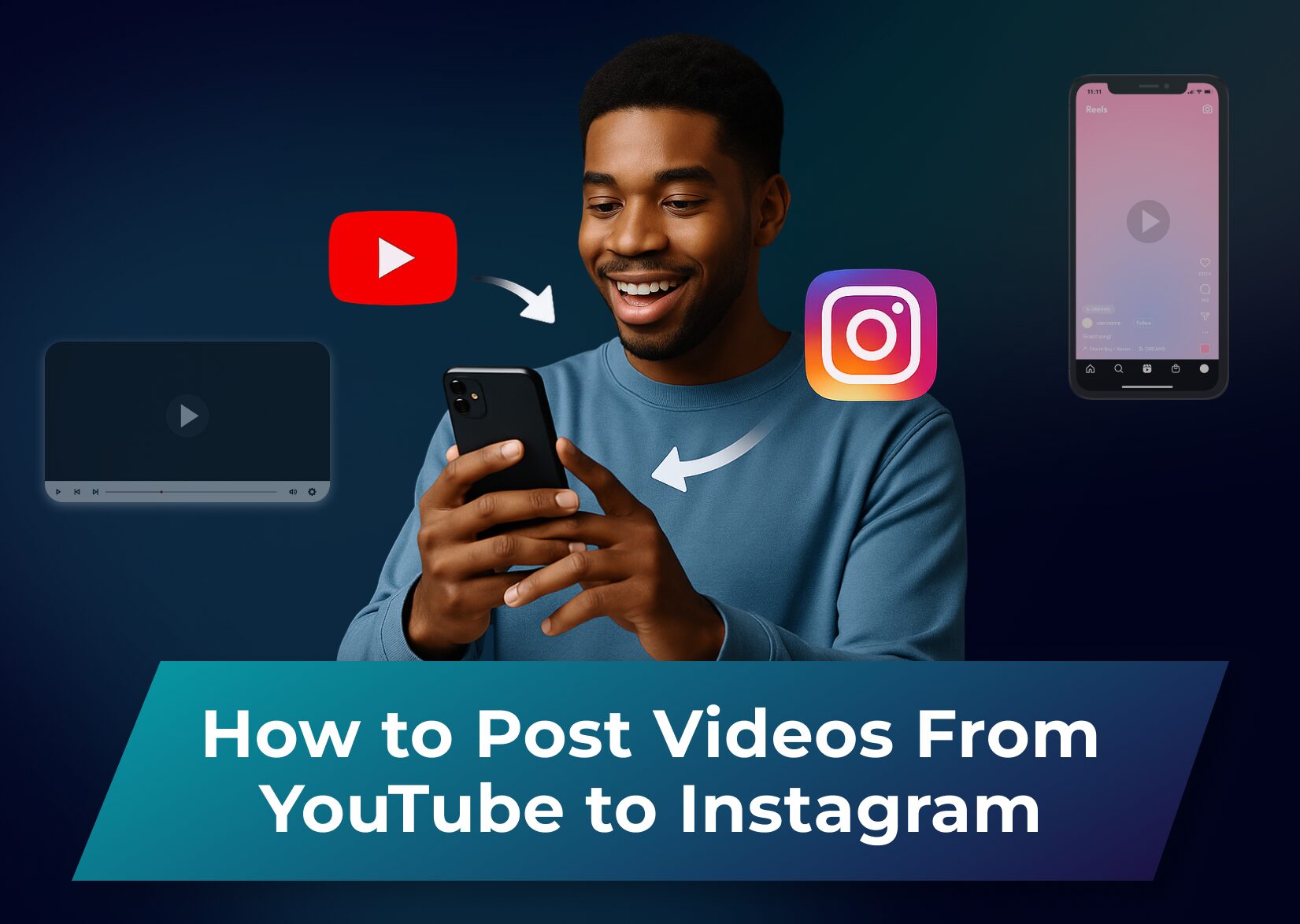How to Post Videos From YouTube to Instagram: Full Guide

Are you a YouTuber who wants to conquer a new social media platform? Or are you seeking quick growth by utilizing both platforms at the same time? Sharing your YouTube content on Instagram is a smart strategy to expand your audience and increase engagement. As a content creator, you’re likely already investing significant time and effort into producing high-quality videos for YouTube – why not maximize their reach by adapting them for Instagram as well? The process isn’t as straightforward as simply uploading the same file, but with the right approach, you can efficiently repurpose your content to suit Instagram’s format requirements.
In this step-by-step guide, we’ll walk you through everything you need to know about transferring your YouTube videos to Instagram. From understanding the technical specifications and formatting differences between platforms to exploring the various options for posting – as feed posts, Stories, or Reels – we’ve got you covered. You’ll learn how to overcome common challenges like Instagram’s duration limits and aspect ratio requirements, as well as discover useful tools that can streamline your workflow. By the end of this article, you’ll have a clear, step-by-step process for sharing your YouTube content on Instagram while maintaining quality and optimizing engagement on both platforms.
Table of Contents
Why Share YouTube Videos on Instagram?
The strategic advantage of cross-posting cannot be overstated – it allows you to enjoy maximum content engagement without doubling your production workload. When a video performs well on YouTube, adapting the same content for Instagram can help you capitalize on that success and create momentum.
When you share a YouTube video on Instagram, you’re strategically extending your reach and creating new opportunities for audience growth. Instagram’s visually focused platform offers a complementary space to showcase your video content, as the Instagram audience includes users who might not regularly visit YouTube.
By cross-posting your YouTube videos to Instagram, you can significantly broaden your audience base. The two platforms often have different user demographics and browsing habits, meaning you’ll connect with viewers who might otherwise never discover your content. This increased visibility translates directly into more views, followers, and engagement across both platforms.
Perhaps most importantly, repurposing your existing YouTube videos for Instagram is an efficient use of your time and resources. Rather than creating entirely new content for each platform, you can adapt what you’ve already produced, making minor adjustments to meet Instagram’s specifications. This approach allows you to maintain a consistent posting schedule while still delivering quality content tailored to each platform’s unique requirements.
Preparing YouTube Videos for Instagram
Before you can share your YouTube content on Instagram, you’ll need to make some adjustments to ensure your videos look great and perform well. Instagram and YouTube have different audiences and therefore different content specifications (for example, unlike YouTube, IG doesn’t favor widescreen videos), so if you want better engagement, be ready to take your time to properly prepare your content. Here’s how to get your YouTube videos ready for Instagram:
Download Videos from YouTube
The first step is obtaining a copy of your YouTube video that you can edit and upload to Instagram. The easiest and most logical way is to simply use the original file that you uploaded on YouTube. If you no longer have access to it, there are several reliable tools that can help with this:
- YT5s.com: This user-friendly online downloader allows you to paste your YouTube video URL and download the video in various qualities. It’s free and doesn’t require installation.
- YouTube Studio: You can access the original file directly from your computer or download it from YouTube Studio if you no longer have the original.
Remember to only use videos that you have the right to use and share on other platforms.
Edit Your Video for Instagram Optimization
Once you have your video file, you’ll need to optimize it for Instagram’s platform specifications:
- Trim for length: Instagram posts can be up to 60 minutes long, while Reels can be up to 3 minutes.
- Adjust pacing: Instagram viewers typically prefer faster-paced content than YouTube users. Make sure to include on-screen prompts and eye-catching captions, and finish your clip with a call to action (CTA).
- Add captions: Research says about 92% of consumers watch videos with the sound off and 50% rely on captions, which makes it imperative that you create videos that are optimized for silent viewing. Adding captions ensures your message comes across regardless of video length and topic. The Dubs app features automatic subtitles that can be translated into over 100 languages, making it a great tool for gaining Instagram followers from all around the world.
Resize YouTube Videos to Instagram-Friendly Aspect Ratios
Instagram favors different aspect ratios than YouTube’s standard 16:9 horizontal format:
- Instagram Feed: 1:1 (square), or 4:5 (vertical rectangle) or 16:9 as well as 9:16 for longer clips
- Instagram Stories and Reels: 9:16 (full vertical)
Most video editing software allows you to easily adjust your aspect ratio with presets for these common formats. When reformatting, consider how the composition of your video will change and what elements are most important to keep in frame. The Dubs app features an AI-powered video editor with all the features you need to convert video content into the necessary format or length. Its intuitive interface and a vast collection of beautiful templates make it a go-to app for video content creators. Try Dubs for free to see how AI can transform your content and boost its performance!
Crop or Shrink to Preserve Quality
When adapting your YouTube video’s aspect ratio for mobile devices, you have two main options:
- Cropping: This involves cutting off portions of the sides of your video to fit the new dimensions. While this maintains the original size of what remains in the frame, you’ll lose content from the edges.
- Shrinking: This keeps your entire video visible but adds colored borders (usually black or white) to fill the extra space in the new aspect ratio.
For talking-head videos or content where the subject is centered, cropping often works well. For videos where all the visual elements are important, shrinking may be the better choice. Most editing tools offer both options, allowing you to preview the results before finalizing your choice. Let’s take a closer look at several ways in which you can post your adjusted content.
Uploading YouTube Videos to Instagram Posts
Once you’ve properly prepared your video, uploading it to your main feed is relatively straightforward. Begin by opening the Instagram app on your mobile device and tapping the plus icon at the bottom of the screen, then selecting “Post.” From the gallery that appears, locate your edited video file. If you’ve edited the video on your computer, make sure to transfer it to your phone first – either through cloud storage services like Google Drive or Dropbox, or by connecting your device directly.
After selecting your video, you can make minor adjustments using Instagram’s built-in editing tools. These won’t be as powerful as dedicated video editors but can help with the final touches.
Before posting, take time to craft an engaging caption that includes relevant hashtags to increase discoverability. You can also tag collaborators, add a location, and choose whether to share simultaneously to other connected social platforms. For maximum engagement, consider the timing of your post – research suggests that weekdays between 11 AM and 1 PM typically see higher engagement rates for most accounts.
Sharing Videos on Instagram Stories
An Instagram Story is a more casual way to share your content with followers. To add your edited video to Stories, tap the plus icon, then select “Story”, then choose your prepared clip from the gallery. Keep in mind that Stories have a 15-second limit per segment, so longer videos will automatically be split into multiple consecutive Stories.
The Instagram Stories format provides several advantages for sharing videos. You can add interactive elements like polls, questions, or quizzes to boost engagement. The “Swipe Up” feature (available to accounts with 10,000+ followers or verified status) allows you to insert a YouTube video link directly into your Story, creating a seamless pathway for viewers to find your full content.
From Camera Roll to Instagram Reels
Instagram Reels offer the perfect format for displaying clips from your YouTube videos. To share your edited content as a Reel, open Instagram and tap the plus icon, then select “Reel” from the bottom menu. Unlike regular posts or Stories, Reels allow videos up to 90 seconds long, giving you more flexibility when repurposing content.
After selecting your pre-edited video from your camera roll, you can enhance it using Reels-specific features. Add trending audio tracks to increase discoverability, apply text overlays to emphasize key points, or utilize Instagram’s AR effects to add a creative touch. The platform’s alignment tools and timer features can also help if you’re combining multiple clips from your YouTube video.
Reels benefit from Instagram’s recommendation algorithm, potentially exposing your content to users beyond your follower base. This makes Reels particularly valuable for growing your audience. When crafting your video description, include relevant hashtags and a CTA directing viewers to your YouTube channel for the full video. For maximum impact, post your Reels during peak engagement hours and respond promptly to comments to boost the algorithm’s favor and extend your reach.
Best Practices for Reposting Videos from YouTube to Instagram
You can’t simply share a YouTube video and expect instant success in cross-platform promotion. As we’ve said before, your content requires strategic adaptation. Follow these best practices to maximize engagement when repurposing your YouTube videos for Instagram:
Adapt Instagram Videos for Platform-Specific Audiences
Instagram users typically expect shorter, more visually striking content than YouTube viewers. Focus on extracting the most compelling moments from your YouTube videos – highlight dramatic reveals, emotional reactions, or key takeaways. Consider your Instagram audience’s preferences and attention span (typically shorter than required on YouTube) when selecting which segments to share.
Optimize Audio Experience
Many Instagram users browse with the sound off, so your repurposed content needs to work on mute. When reposting YouTube videos on Instagram, add captions or text overlays to convey important information. When sound is crucial to the experience, add a “Sound On” graphic to encourage viewers to enable audio.
Create Custom Thumbnails and Cover Images
First impressions matter enormously on the Instagram app. Design eye-catching cover images that align with your brand aesthetic while conveying what viewers can expect. A compelling thumbnail can significantly improve click-through rates.
Add CTAs to Drive Traffic to Your YouTube Channel
Use your Instagram captions strategically to drive viewers to your original YouTube video. Include clear calls-to-action like “Watch the full tutorial on YouTube” with a YouTube link in your bio or Stories. This creates a cross-platform content ecosystem that benefits both channels.
Maintain Consistent Posting Schedule
Consistency builds audience expectations and improves algorithm performance. Develop a content calendar that coordinates your YouTube and Instagram posting schedules. Many creators find success by posting YouTube content first, then sharing Instagram versions a few days later to extend the content lifecycle.
Track Cross-Platform Performance
Monitor which types of repurposed content perform best on Instagram versus YouTube. Use analytics to identify patterns in engagement rates, watch time, and conversion between platforms. This data will help you refine your cross-posting strategy over time.
More articles

150+ Best Vacation Instagram Captions to Make Your Travel Photos Pop
Planning your dream vacation is exciting, but finding the perfect words to accompany those stunning photos can be challenging. Whether you’re lounging on a tropical beach, exploring ancient ruins, or hiking breathtaking mountains, the right caption can elevate your Instagram post from ordinary to unforgettable. You’ve packed your bags for the family vacation, created memories, […]

175+ Unforgettable Prom Instagram Captions to Make Your Night Shine | 2025 Edition
Capturing the magic of prom night on Instagram requires more than just stunning photos – you need the perfect caption to complete your post. Whether you’re looking for something sentimental, funny, referencing your favorite song lyrics, or the photos from the dance floor, the right words can make your prom memories shine even brighter on […]

200+ Beach Instagram Captions: From Funny to Inspirational Quotes
Looking for the perfect words to pair with your beach photos? You’re not alone. A day at the shore isn’t truly complete until you’ve captured those sun-soaked moments and shared them with a caption that perfectly complements your vibe. Whether you’re posting golden hour selfies, documenting beach games, or showcasing those “sunkissed nose, sandy toes” […]